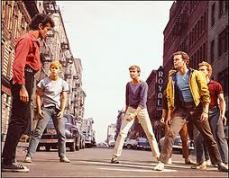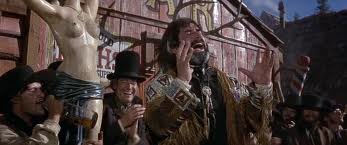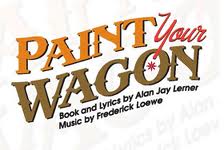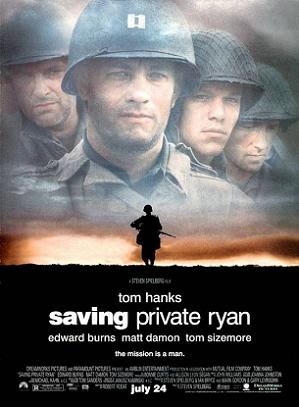 West Side Story is a 1961 musical film directed by Robert Wise and Jerome Robbins. The film is an adaptation of the 1957 Broadway musical of the same name, which in turn was adapted from William Shakespeare’s play Romeo and Juliet. It stars Natalie Wood,Richard Beymer, Russ Tamblyn, Rita Moreno and George Chakiris and it was photographed by Daniel L. Fapp, A.S.C., in Super Panavision 70.
West Side Story is a 1961 musical film directed by Robert Wise and Jerome Robbins. The film is an adaptation of the 1957 Broadway musical of the same name, which in turn was adapted from William Shakespeare’s play Romeo and Juliet. It stars Natalie Wood,Richard Beymer, Russ Tamblyn, Rita Moreno and George Chakiris and it was photographed by Daniel L. Fapp, A.S.C., in Super Panavision 70.
The film’s opening sequence was shot on the streets of New York City, mainly in the area where the Lincoln Center for the Performing Arts campus of Fordham University now stands. Veteran director Robert Wise was chosen as the director and producer because of his familiarity with urban New York dramas, such as Odds Against Tomorrow. Wise had never directed a musical before and when it was suggested that Jerome Robbins, who had directed the stage version, be brought in to handle all the music and dance sequences in the film, Wise agreed. After about one-third of the movie had been shot, the Mirisch Company, which had become increasingly concerned that the production was over-budget, fired Robbins, who, according to Saul Chaplin in his autobiography, nearly suffered a nervous breakdown during the time he worked on the film. The  remaining dance numbers were handled by Robbins’ assistants. However, because of his great creative contribution to the film, Wise agreed Robbins be given co-directing credit, even though Wise directed the majority of the film himself. The ending title sequence was created by Saul Bass, who is also credited as «visual consultant» on the film.
remaining dance numbers were handled by Robbins’ assistants. However, because of his great creative contribution to the film, Wise agreed Robbins be given co-directing credit, even though Wise directed the majority of the film himself. The ending title sequence was created by Saul Bass, who is also credited as «visual consultant» on the film.
The film was released on October 18, 1961, through United Artists. It received praise from critics and the public, and became the second highest grossing film of the year in the  United States. The film won ten Academy Awards in its eleven nominated categories, including Best Picture, as well as a special award for Robbins. West Side Story holds the distinction of having won more Academy Awards than any other musical film (unless one counts the Honorary Award given to Maurice Chevalier in 1959, the year that Gigi won its nine Oscars). The soundtrack album sold more copies than any soundtrack album before it, and more than the original cast album did.
United States. The film won ten Academy Awards in its eleven nominated categories, including Best Picture, as well as a special award for Robbins. West Side Story holds the distinction of having won more Academy Awards than any other musical film (unless one counts the Honorary Award given to Maurice Chevalier in 1959, the year that Gigi won its nine Oscars). The soundtrack album sold more copies than any soundtrack album before it, and more than the original cast album did.
The film opens in the streets of Manhattan in the late summer of 1957. There is a mounting tension set to music («Prologue«) between a white American gang, the Jets, led by Riff Lorton (Russ Tamblyn), and a rival gang of Puerto Rican immigrants, the Sharks, led by Bernardo Nunez (George Chakiris). The Jets harass the Sharks and vice versa, culminating in a free-for-all throughout the streets.
Riff decides that his best friend Tony Wycek (Richard Beymer), a co-founder of the Jets who has left the gang to work at a local candy/drug store, would be the best member to present the challenge to the Sharks because he has always come through for the Jets. This is the plot for The Jet Song.
Dance at the Gym. Tony and María’s first meeting
Maria is sent home, and Anita argues with Bernardo that they are in America, not Puerto Rico. At the Sharks’ apartment building, Anita and other girls from Puerto Rico engage in a spirited argument with Bernardo in defense of Maria’s right to dance with whomever she pleases. They debate the advantages and disadvantages of their country. This is the song America. Click next if you want to get the lyrics: West Side Story America
Tony discreetly visits Maria outside the fire escape at her home and they confirm their love. They arrange to meet the next day at the bridal shop where Maria works. This is the story surrounding the number Tonight.
The Jets gather outside Doc’s store to wait for the Sharks. They are visited by Officer Krupke, who warns them not to cause trouble on his beat. After he leaves, they lampoon him and the various theories of how to deal with juvenile delinquency. This is the number Gee, Officer Krupke!
Tony, who is in a good mood and alone with Doc in the store to clean up, surprises Doc and tells him about his love for Maria. The day comes to an end as a distressed Doc closes the store and Tony leaves. The next day at Madam Lucia’s bridal shop, Maria sings to her co-workers about how happy and excited she is in the song I Feel Pretty.
A musical montage («Quintet«) intertwines the feelings of the Jets and Sharks in anticipation of the rumble, Tony and Maria’s anticipation of meeting each other, and Anita preparing for her date with Bernardo.
The Jets and Sharks arrive at their agreed location for the rumble, a fenced dead-end under a stretch of New York highway. As the «fair fight» begins between Bernardo and Ice, Tony arrives and tries to stop it, but is met  with ridicule and mockery from Bernardo and the Sharks. Unable to stand by and watch his best friend be humiliated, Riff angrily lashes out and punches Bernardo («The Rumble«). Drawing their knives, Riff and Bernardo fight each other. Once Riff gets the upper hand, Tony stops him. However, Riff breaks away and runs back into the fight, only to be stabbed by Bernardo. Riff collapses while handing the knife to Tony and Bernardo looks shocked at what he has done. Enraged, Tony kills Bernardo with Riff’s knife, resulting in a full-fledged melee. Suddenly, police sirens blare out and the gang members flee, leaving behind the bodies of Riff and Bernardo.
with ridicule and mockery from Bernardo and the Sharks. Unable to stand by and watch his best friend be humiliated, Riff angrily lashes out and punches Bernardo («The Rumble«). Drawing their knives, Riff and Bernardo fight each other. Once Riff gets the upper hand, Tony stops him. However, Riff breaks away and runs back into the fight, only to be stabbed by Bernardo. Riff collapses while handing the knife to Tony and Bernardo looks shocked at what he has done. Enraged, Tony kills Bernardo with Riff’s knife, resulting in a full-fledged melee. Suddenly, police sirens blare out and the gang members flee, leaving behind the bodies of Riff and Bernardo.
Unaware of what has happened, Maria is waiting for Tony on the roof of her apartment building. One of the Sharks, Chino (Jose DeVega), whom Maria has been promised to, arrives and angrily tells her that Tony killed her brother. Tony arrives, and initially Maria lashes out at him in anger, but Tony explains what happened and asks for her forgiveness before he plans to turn himself in to the police. Maria decides that she still loves Tony and begs him to stay with her. They reaffirm their love (in the song Somewhere), kiss, and make love for the first time (offscreen).
Meanwhile, the Jets (with Ice now in command and joined by the Jet girls) have reassembled outside a garage. Action demands revenge for Riff’s death, but Baby John opposes it. Action yells at Baby John for being scared, then tensions flare amongst several Jets. Ice pulls them all into the garage and tells them they will have their revenge on the Sharks, but must do it carefully (Cool song).
 You know that I don’t usually tell the end of a story, but this is a revisitation of Romeo and Juliet, so I expect that most of you know what is going on here. At the end of the story, on the playground next to Doc’s store, Tony suddenly sees Maria and they begin to run toward each other with joy. Suddenly, Chino appears and shoots Tony. As the Jets and Sharks arrive, Maria and a fatally wounded Tony reaffirm their love («Somewhere«), but Tony dies in her arms. Maria takes the gun from Chino and blames the rival gang members for the deaths of Tony, Bernardo, and Riff with their hate, threatening to kill as many of them as she can, while still leaving one bullet for herself. However, she can’t do it and drops the gun before sinking to the ground, crying. Three of the Jets start lifting his body and two Sharks join them to help carry him off. Maria and several Jets and Sharks walk behind them in a funeral procession and Chino is arrested by Schrank and Krupke for killing Tony.
You know that I don’t usually tell the end of a story, but this is a revisitation of Romeo and Juliet, so I expect that most of you know what is going on here. At the end of the story, on the playground next to Doc’s store, Tony suddenly sees Maria and they begin to run toward each other with joy. Suddenly, Chino appears and shoots Tony. As the Jets and Sharks arrive, Maria and a fatally wounded Tony reaffirm their love («Somewhere«), but Tony dies in her arms. Maria takes the gun from Chino and blames the rival gang members for the deaths of Tony, Bernardo, and Riff with their hate, threatening to kill as many of them as she can, while still leaving one bullet for herself. However, she can’t do it and drops the gun before sinking to the ground, crying. Three of the Jets start lifting his body and two Sharks join them to help carry him off. Maria and several Jets and Sharks walk behind them in a funeral procession and Chino is arrested by Schrank and Krupke for killing Tony.
I also post the ending titles because they are absolutely brilliant, modern and avant-garde, designed by the great Saul Bass, and they haven’t lost a bit of their up-to-date quality after more than fifty years from the release of the film.


































